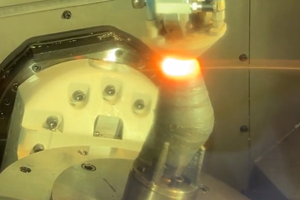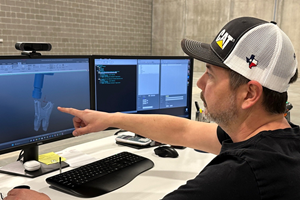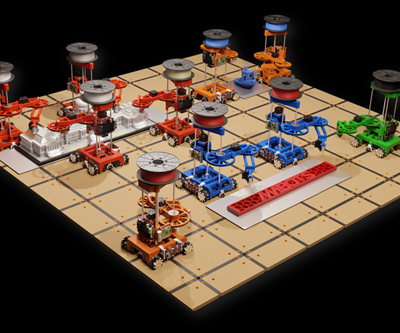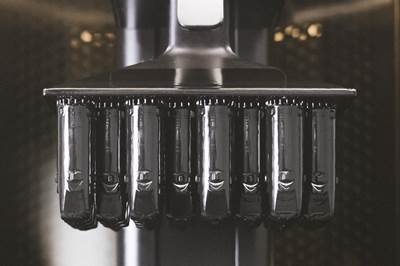Additive Manufacturing Via Material Extrusion
Material extrusion was the second additive manufacturing process to be successfully commercialized. After three decades of material advancements and a diverse array of start-ups and applications, the use cases for this technology are still going strong.
Share





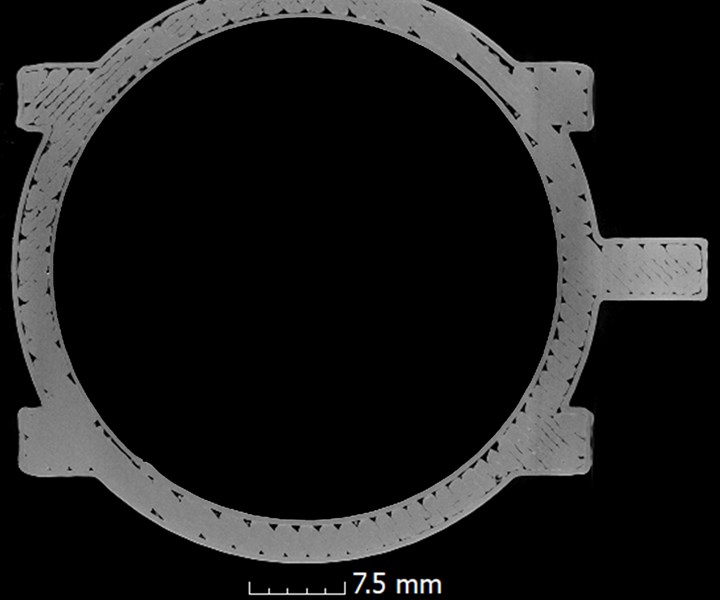
A computed tomography (CT) scan of the inside of a part made via material extrusion shows how deposition strategy (e.g., tool path, contour, road width) affects the infill and density. Image credit: Timothy W. Simpson.
If you recall from last month’s column, ASTM/ISO define seven different types of processes for additive manufacturing (AM): powder-bed fusion, directed energy deposition, binder jetting, vat photopolymerization, material extrusion, material jetting and sheet lamination. This month we will focus on material extrusion, the second AM process to reach the market and see commercial success. Thanks to material advancements and a diverse array of start-ups and applications, material extrusion is still driving a lot of excitement three decades after its introduction.
Material extrusion was invented and patented by Scott Crump in 1989 and introduced to the market as Fused Deposition Modeling (FDM) by Stratasys, the company Mr. Crump co-founded. Stratasys popularized the use of FDM in a variety of industries. Given FDM’s capability of additively manufacturing prototypes, concept models, tooling/fixtures/jigs and more in a variety of different plastics, Stratasys, at the time, became the dominant player for material extrusion systems (much like 3D Systems did for vat photopolymerization as discussed last month). In fact, FDM became synonymous with material extrusion the same way many people ask for a Kleenex instead of a facial tissue.
As key patents started to expire, material extrusion technology was embraced by the open source community, giving rise to FFF (fused-filament fabrication) systems and eventually RepRaps, 3D printers that could replicate themselves. This open source revolution spawned hundreds of material extrusion start-ups, mostly notably MakerBot, which was acquired by Stratasys for more than $400 million in 2013 (check out the documentary, Print the Legend if you want to learn the full story). While this acquisition frustrated many in the open source community, the next wave of the AM revolution was launched and remains strong to this day thanks to new start-ups and new capabilities.
As the name implies, material extrusion extrudes a material through a nozzle (or orifice) and selectively deposits material layer-by-layer to form an object. Material extrusion is kind of like squeezing toothpaste out of the tube, except that plastic hardens a lot faster after it is extruded and cools down. Most material extrusion systems use a spool of plastic filament as the feedstock, which costs about $20 per kilogram for standard materials (PLA, ABS, PC and more). Proprietary filaments can be two to three times more expensive, and advanced materials (nylon, flexible filaments, carbon fiber-reinforced filaments) can easily run $40 per kilogram or more. The systems themselves can cost less than $1,000 for an entry-level system for home use, or they can range from $5,000 to $10,000 for a desktop system for prototyping and tooling to $150,000 and more for industrial-grade systems.
Industrial-grade systems offer faster build rates and larger build volumes. Some large-scale industrial systems come equipped with pellet feeders, which increase material feed rates even more dramatically. Pellets can also be bought in bulk for about a fifth of the cost of filament, and it is easy to add chopped carbon fiber, for instance, to pellet feeders to improve strength. This combination enabled Big Area Additive Manufacturing (BAAM), a material extrusion technology developed by Oak Ridge National Laboratory and machine tool manufacturer Cincinnati Incorporated that can additively manufacture a full-scale vehicle chassis in just days. They have since claimed the Guinness World Record for the largest solid 3D printed object, namely, a wing trim-and-drill tool for Boeing. Local Motors initially used BAAM technology to additively manufacture the chassis for Olli, a small commuter bus that is easily customized for different municipalities. It now uses Thermwood’s large-scale additive manufacturing (LSAM) technology to 3D print 90% of the vehicle.
Despite these advances, material extrusion does have its drawbacks. First, it is a lot slower than injection molding — parts can take hours (or sometimes days) to build versus seconds. On the plus side, material extrusion does not require any molds or tooling to fabricate a part. This is why cost tradeoff curves for AM show a flat line for material extrusion as the production quantity increases compared to the decreasing slope when using injection molding. Thus, a good use case for material extrusion arises when production volumes are low and tooling costs are high. This is why companies like Airbus, Boeing, Lockheed Martin and others additively manufacture complex ductwork components using ULTEM 9805, one of the few FAA-certified polymers for material extrusion. Meanwhile, countless machine shops are finding use for consumer-grade material extrusion systems to make custom fixtures and jigs and improve production efficiency, and the costs of these desktop systems are so low that companies can break even in as little as one to two months. It has never been as easy to make the business case for one of these systems as it is today.
Another big drawback of material extrusion is part strength. Parts made by material extrusion are not fully dense (see the image), and anisotropy arises due to layer-by-layer fabrication. The latter occurs because the “weld strength” between layers is not as strong as the strength within a layer due to the way that polymers gain strength during processing. Injection molding techniques are fully dense and do not suffer from this anisotropy because the entire plastic part is heated and pressurized in the mold during fabrication. This leads to stronger parts via injection molding, but process improvements along with a better understanding of the impact of different process parameters are slowly closing this gap. Meanwhile, advancements in the technology, combined with new material feedstocks, are enabling the use of carbon fiber, Kevlar and even metallic particles to be embedded in filament and additively manufactured with material extrusion. This is game-changing for material extrusion.
Related Content
Digitalization and Done-In-One Reign Supreme at BIEMH 2024
European manufacturers may have a different balance of markets than their U.S. counterparts, but the practical challenges they must overcome are often similar — as are the solutions.
Read MoreAdditive/Subtractive Hybrid CNC Machine Tools Continue to Make Gains (Includes Video)
The hybrid machine tool is an idea that continues to advance. Two important developments of recent years expand the possibilities for this platform.
Read MoreDigital Transparency in Machining Key to Multi-Site Additive Manufacturing
Cumberland Additive’s CNC programmer in Pennsylvania spends most of his time writing programs for machine tools in Texas.
Read More6 Trends in Additive Manufacturing Technology
IMTS 2024 features a larger Additive Manufacturing Pavilion than ever before, with veteran suppliers alongside startups and newcomers at the front of the West Building. As you browse these exhibitors, as well as booths found elsewhere at the show, keep an eye out for these trends in AM.
Read MoreRead Next
Robots, Assemble! A New Path to Autonomous Mobile 3D Printing
Robot swarms may sound alarming, but research at the University of Arkansas reveals that they may enable a new, ultra-efficient era of automated manufacturing and 3D printing.
Read MoreWhat Is Vat Photopolymerization?
Vat photopolymerization was the first AM process to be successfully commercialized. Three decades later, this technology has shown how AM is capable of scaling to volume production and making custom products on demand.
Read MoreBuilding Out a Foundation for Student Machinists
Autodesk and Haas have teamed up to produce an introductory course for students that covers the basics of CAD, CAM and CNC while providing them with a portfolio part.
Read More
























